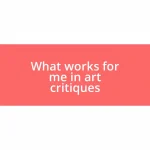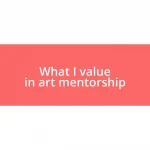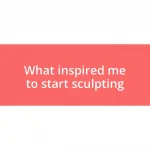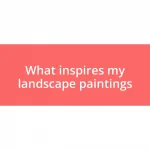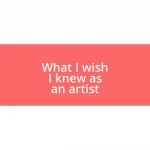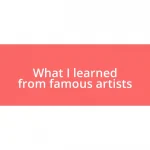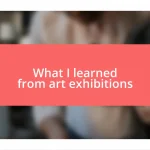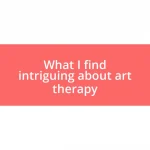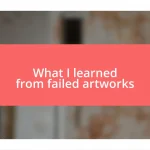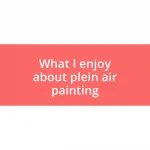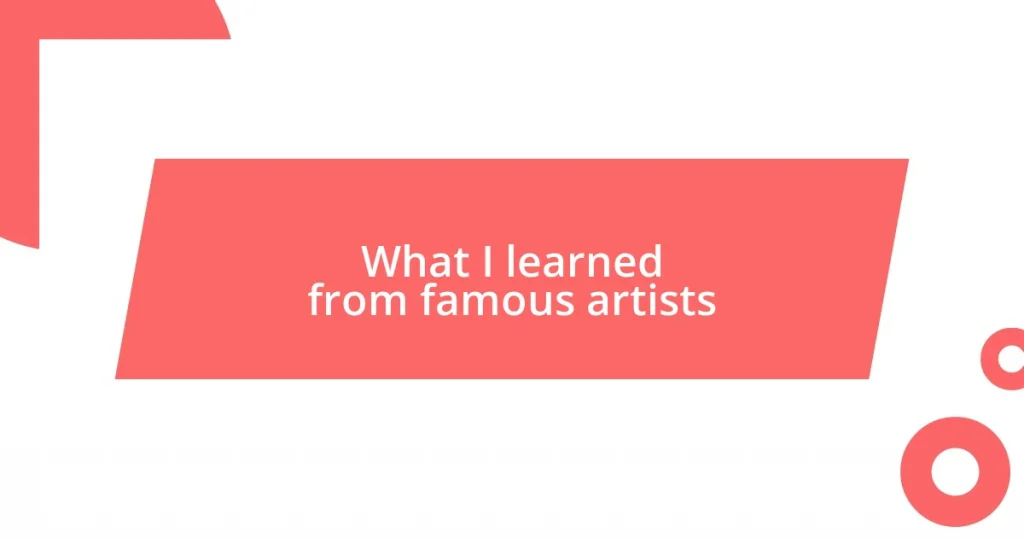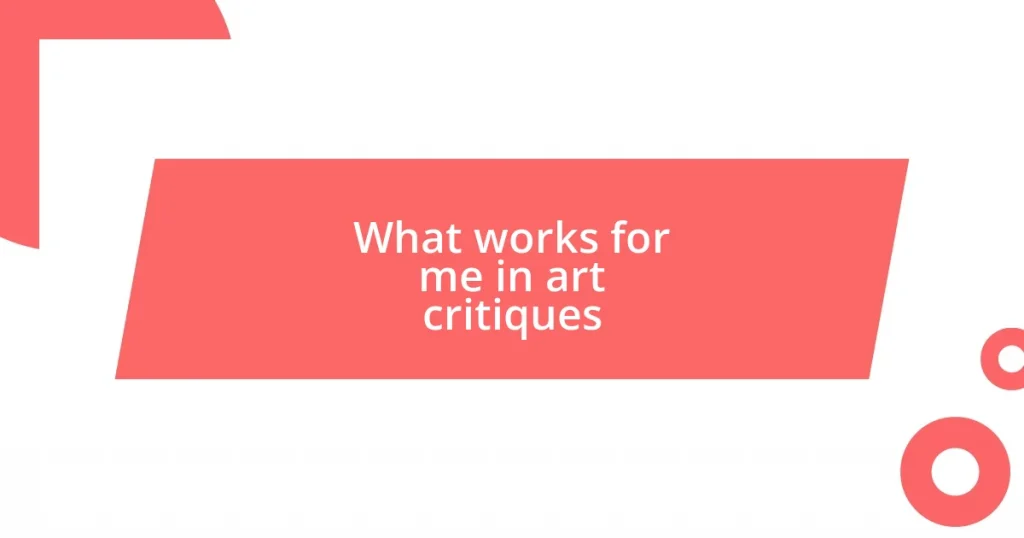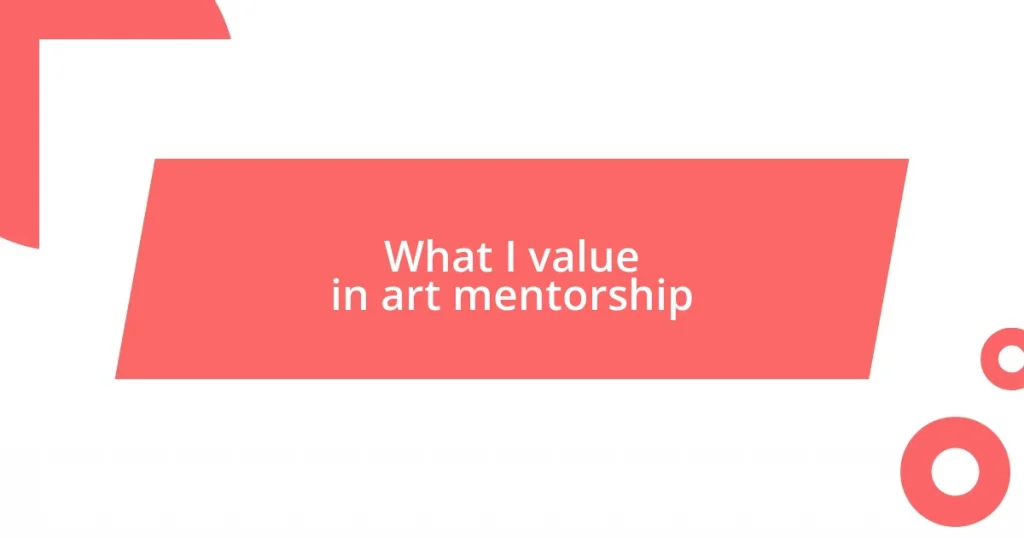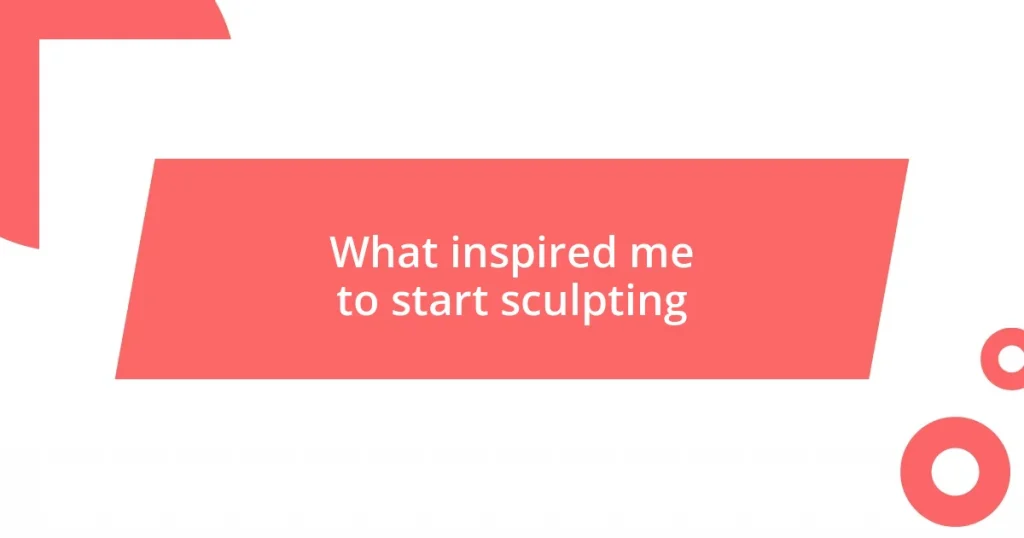Key takeaways:
- Art can be a powerful tool for expressing emotions, identity, and social commentary, as demonstrated by Van Gogh, Kahlo, and Picasso.
- Engaging with various artistic techniques and movements can enhance personal creativity, encouraging experimentation and spontaneity.
- Collaboration and active audience engagement are vital for overcoming creative blocks and enriching the artistic process.
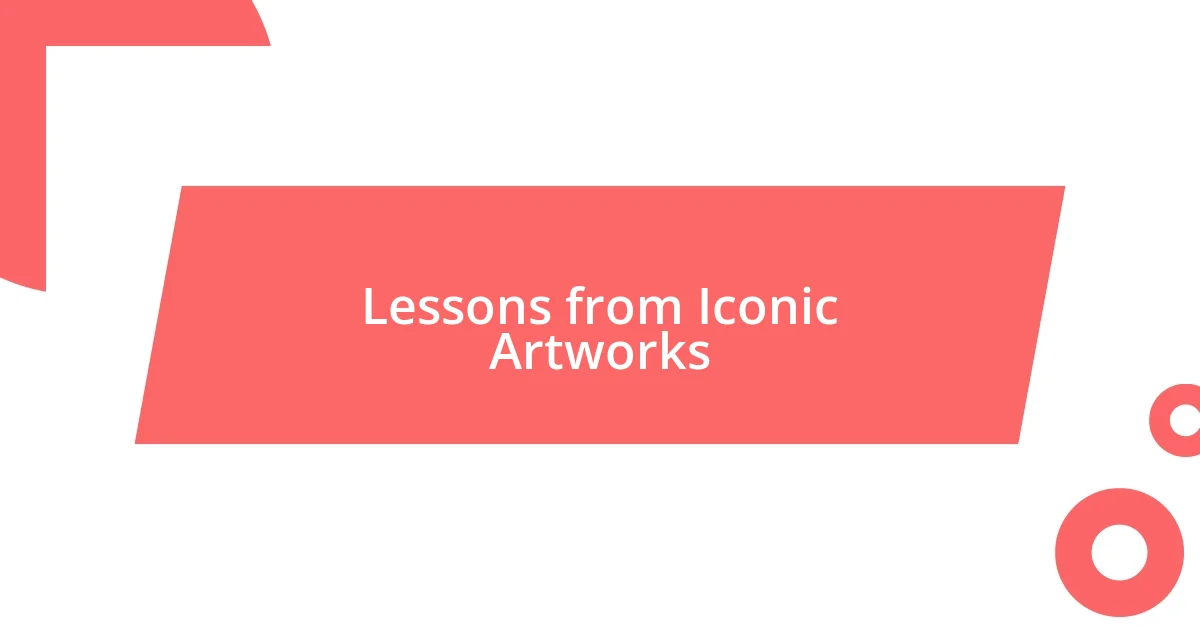
Lessons from Iconic Artworks
When I first encountered Van Gogh’s “Starry Night,” I was struck by how color can convey intense emotions. The swirling skies spoke to me of chaos and beauty, reminding me that life isn’t just about the calm moments; it’s about embracing the turbulent ones too. Have you ever felt overwhelmed but found solace in expressing that chaos? Van Gogh teaches us to celebrate our feelings, even the messy ones.
Then there’s Frida Kahlo’s “The Two Fridas,” which profoundly influenced my views on identity and duality. The juxtaposition of her two selves—one vulnerable, the other strong—encouraged me to reflect on my complexities and how they shape who I am. This artwork made me wonder: how often do we hide parts of ourselves that are just as important? Kahlo’s courage to expose her inner struggles reminds us that honesty about our identities can be empowering.
Finally, Picasso’s “Guernica” haunts me with its raw portrayal of suffering and conflict. The distorted figures and chaotic forms provoke a visceral response, compelling viewers to confront the brutality of war. I ask myself, why do we often shy away from discomfort in art? This piece taught me that art is a powerful tool for social commentary, urging us to face harsh realities rather than turn a blind eye.
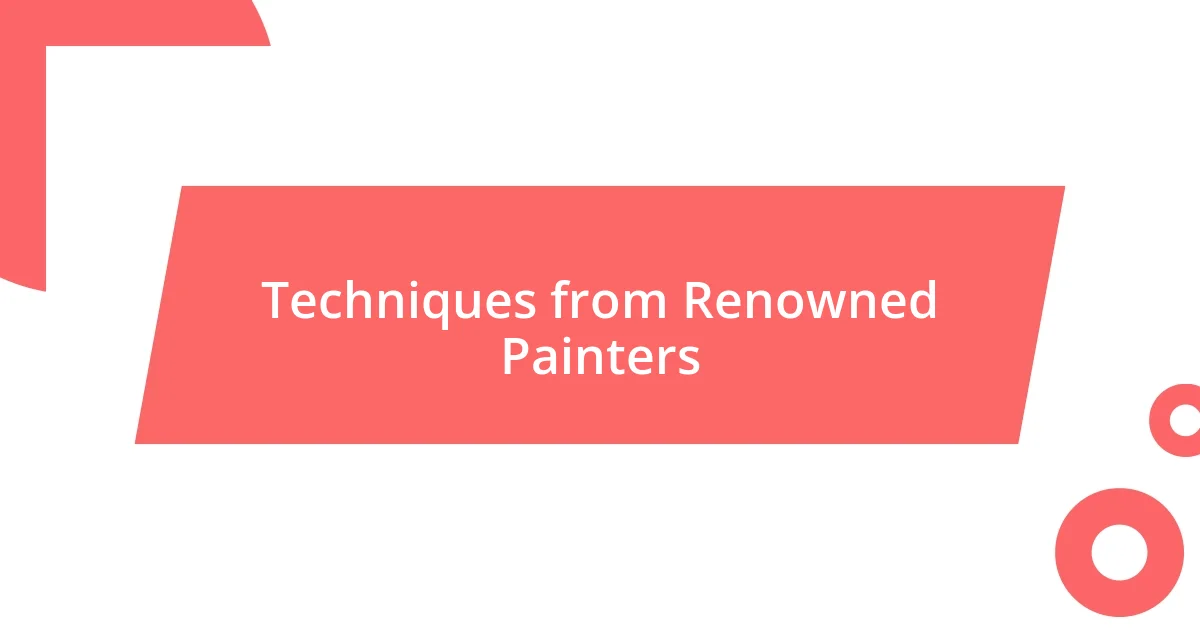
Techniques from Renowned Painters
Exploring the techniques of renowned painters has truly transformed my understanding of art. For instance, the way Claude Monet masterfully used light and color in his impressionist works has inspired me to appreciate the subtleties of natural beauty. I remember standing before “Water Lilies,” feeling as if I was right beside the lilies floating on the pond, absorbed in his brushwork that captures fleeting moments in time. It’s a reminder of the importance of observation in art and life.
Here are some techniques I find striking from various artists:
- Layering Colors: Monet’s approach included building layers of color to create depth and light, reminding me to embrace complexity in my own work.
- Emotional Brushwork: Van Gogh’s expressive brushstrokes convey emotion directly—his technique encourages me to let feelings guide my art.
- Symbolism: Kahlo often infused her pieces with personal symbols, teaching me the power of storytelling through imagery.
- Dynamic Composition: Picasso’s fractured perspectives in works like “Les Demoiselles d’Avignon” challenge traditional views and inspire me to think outside the box in my compositions.
- Textural Elements: Artists like Jackson Pollock showcased texture through dripping paint, illuminating for me the importance of tactile experiences in visual art.
Each of these artists, with their unique techniques, opens up new pathways for expression, inviting me to experiment and explore my artistic voice further.
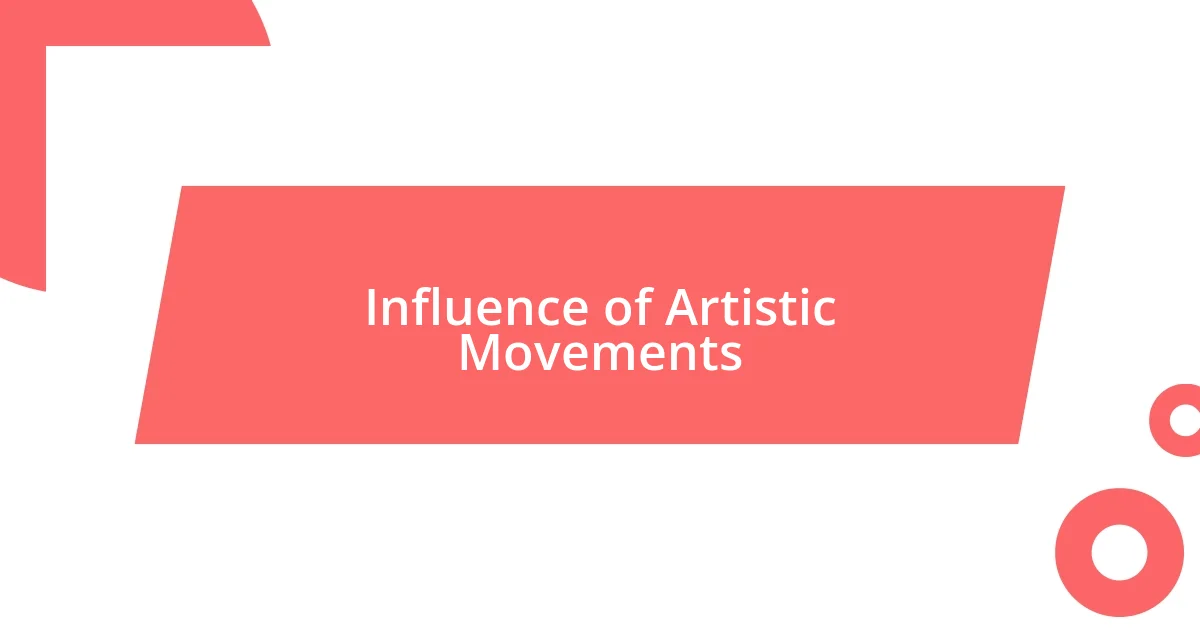
Influence of Artistic Movements
The influence of artistic movements on my perspective is palpable. Take the Renaissance, for example. As I studied the intricacies of Leonardo da Vinci’s works, I found myself captivated by the way he blended science and art. It struck me that this movement celebrated human potential and intellectual exploration. It’s a reminder that creativity doesn’t exist in a vacuum; it flourishes when we embrace curiosity. Have you ever felt inspired by a different field that sparked your creativity? I certainly have!
Then there’s the boldness of the Abstract Expressionists, like Jackson Pollock. I remember one rainy afternoon, standing in front of one of his drip paintings, feeling utterly overwhelmed by the freedom of expression it encapsulated. The chaotic lines and splatters taught me that true artistry lies in spontaneity. It makes me question: how often do we confine our creativity to rules? Pollock’s movement encourages us to break free, to celebrate the rawness of our emotions and let them guide our artistic journey.
Lastly, the Pop Art movement, led by figures like Andy Warhol, reshaped my understanding of culture and consumerism. I distinctly recall gasping at his vivid representations of everyday items. It dawned on me that our mundane experiences could be transformed into art. Warhol’s work pushes us to ponder our relationship with the world around us—how do we elevate the ordinary? Each artistic movement challenges us to view life through a new lens, shaping not only our creative expressions but also our everyday perceptions.
| Artistic Movement | Influence |
|---|---|
| Renaissance | Emphasized human potential and intellectual exploration, combining art with science. |
| Abstract Expressionism | Encouraged spontaneity and emotional freedom in art, breaking traditional boundaries. |
| Pop Art | Transformed everyday items into art, prompting reflection on culture and consumerism. |
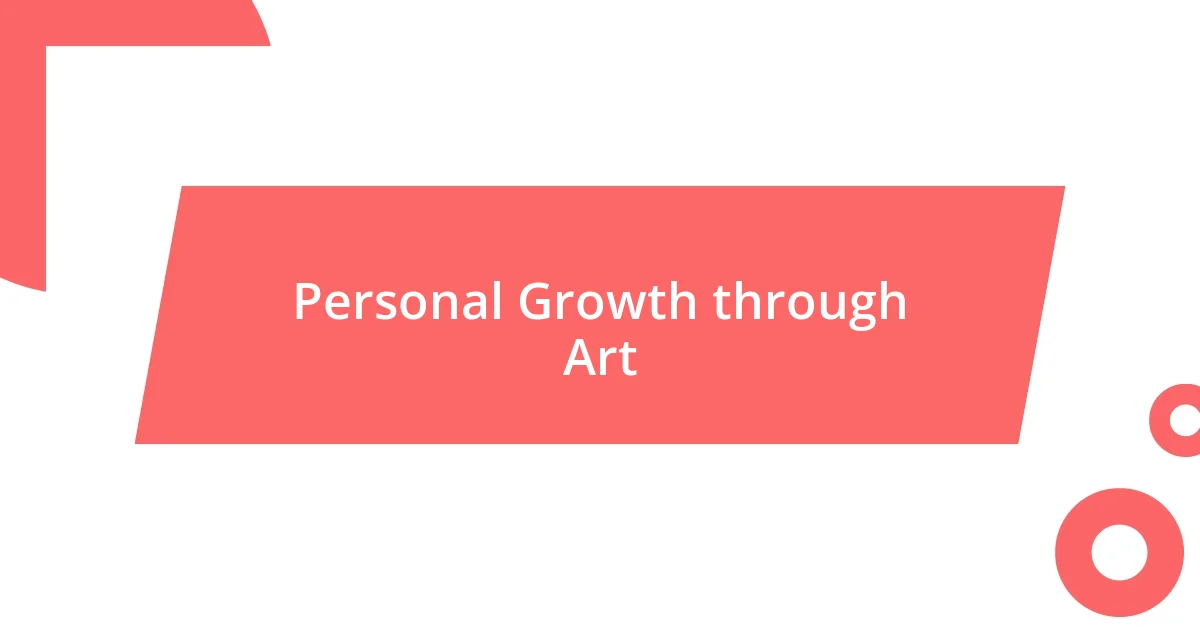
Personal Growth through Art
Art has profoundly influenced my personal growth, offering insights that resonate deeply with my life. I recall a particular day when I stumbled upon a local art exhibition featuring emerging artists. Their raw and unrefined expressions ignited something within me—a realization that vulnerability can be a powerful catalyst for growth. Have you ever noticed how the most authentic pieces often come from a place of honesty? I found that embracing my own imperfections has led to richer, more meaningful art.
Working with different mediums has further expanded my artistic journey. I remember trying my hand at pottery for the first time. The tactile experience of shaping clay was transformative; it taught me the importance of patience and the beauty of imperfections. Each crack in my pot became a story, a reminder that growth often comes from struggle. It’s fascinating to think about how we can find strength in our vulnerabilities, wouldn’t you agree?
Moreover, drawing inspiration from artists like Frida Kahlo has encouraged me to explore my own identity through art. Her commitment to self-exploration in her paintings resonates with me, pushing me to question who I truly am and how I want to express that through creativity. Kahlo’s ability to translate personal pain into art inspires me to be brave and share my own story, reminding me that each stroke of the brush can lead to deeper self-awareness and connection with others.
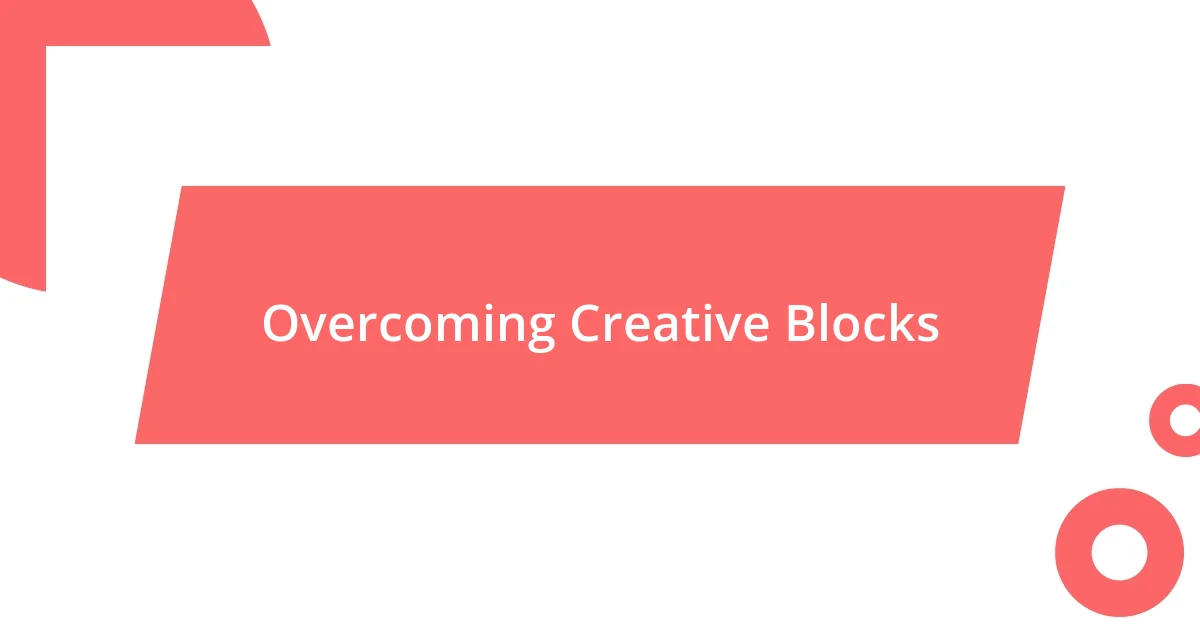
Overcoming Creative Blocks
Creative blocks can feel insurmountable, but even the most renowned artists have faced them. I remember experiencing a particularly discouraging period when I couldn’t pick up a paintbrush for weeks. It was during a visit to a museum that I felt a shift; I saw a piece by Vincent van Gogh, whose vibrant colors spoke to me. That moment reminded me that sometimes, stepping away and experiencing art created by others can reignite our own creative spark. What have you done that helped you rediscover your passion?
Another approach I’ve learned is to embrace the discomfort that comes with a creative rut. I once tried journaling my thoughts to dig deeper into what was blocking me. The act itself felt therapeutic and opened up new ideas that I hadn’t considered before. It reinforced my belief that acknowledging feelings and fears—and putting them down on paper—can lead to unexpected breakthroughs. Have you ever written your way out of a mental block?
I’ve also seen how collaboration can be an antidote to creative stagnation. Working with a friend on a mural project pushed me beyond my expectations. The playful exchange of ideas sparked excitement and ultimately led to a vibrant piece we both cherished. This experience taught me the value of sharing the creative process. When was the last time you collaborated with someone? I find that bouncing ideas off another person can provide fresh perspectives and help dissolve those pesky blocks.
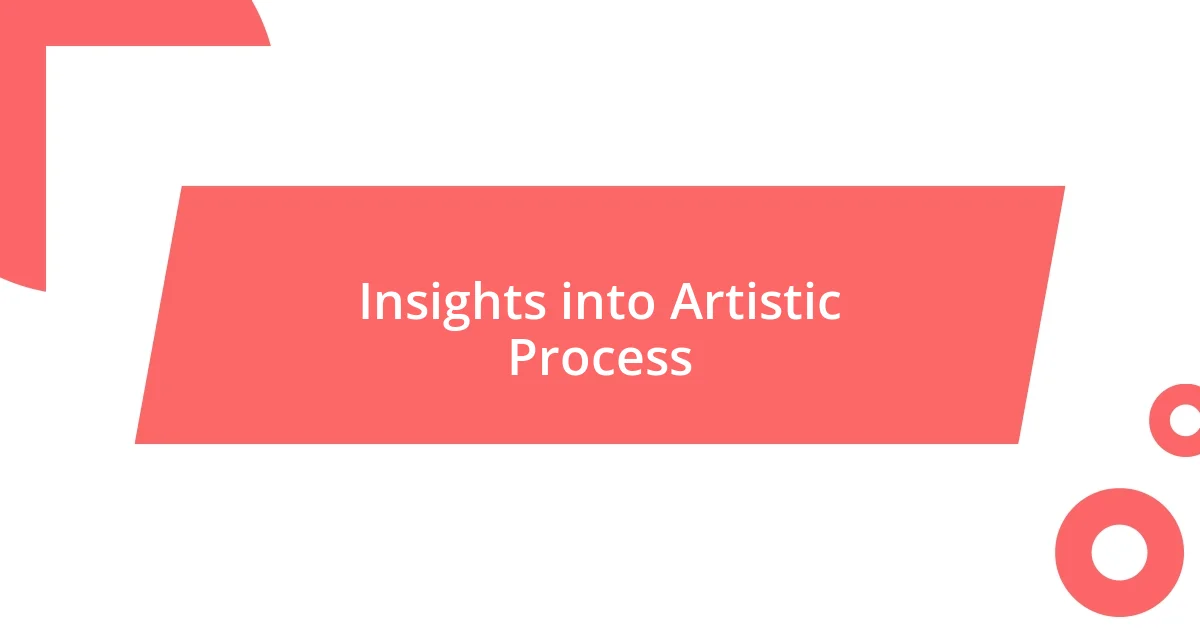
Insights into Artistic Process
The artistic process often involves navigating a labyrinth of thoughts and emotions. I remember being captivated by the way Picasso approached his work, driven by intense personal experiences. It made me reflect on how my own emotional state could influence my creativity. When I’m feeling joyful or even melancholic, it often seeps into my art—it’s like each brushstroke becomes a journal entry. Have you considered how your emotions shape your creative output?
An artist’s practice can also be shaped by experimentation. I once decided to break free from my usual painting style and tried abstract art. Initially, the lack of structure made me anxious, but as I delved deeper, I discovered a newfound sense of freedom. This experience taught me that embracing uncertainty can lead to unexpected creativity. Have you found that stepping outside your comfort zone can open up new avenues for self-expression?
Moreover, the insights I gained from artists like Georgia O’Keeffe resonate deeply with me. Her dedication to observing nature taught me the importance of looking closely at the world around us. During a quiet moment in a garden, I marveled at the details in a single flower petal. This sparked a realization: truly understanding our subjects can enhance our artistic process. I often remind myself that slowing down and appreciating the beauty of simple things can drive inspiration. When was the last time you took a moment to truly observe your surroundings?
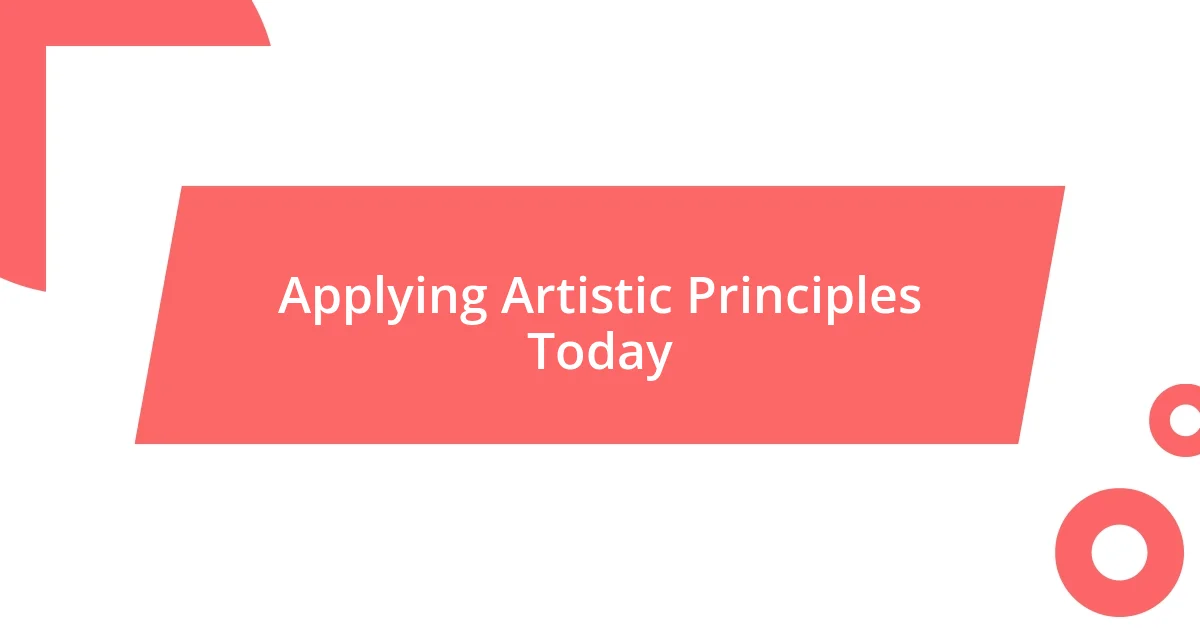
Applying Artistic Principles Today
Artistic principles remain relevant today, and I’ve found that integrating traditional techniques can elevate my work. For instance, I recently experimented with chiaroscuro, the contrast of light and dark, inspired by Caravaggio’s dramatic style. This heightened the emotional impact of my piece and got me thinking: how do light and shadow play into your own art?
In my journey, I’ve learned the importance of storytelling within art. While visiting an art fair, I stumbled upon an artist who combined visual elements with a personal narrative. This opened my eyes to the power of context in art. Crafting a story behind each piece adds layers of meaning—have you tried narrating your own experiences through your creations?
I’ve also realized that audience engagement transforms the way I approach my work. During one exhibit, a conversation with a viewer revealed how they interpreted my piece, providing insights I hadn’t considered. This interaction reminded me that art is not just a solitary endeavor; it thrives in the dialogue it creates. How has your audience shaped the way you view your own creations?
